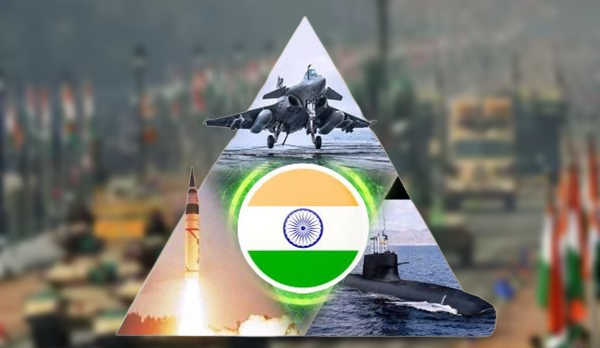
- India’s strategic calculus is shaped by a dual-threat scenario: the longstanding conflict with Pakistan and the strategic competition with China.
- India’s nuclear trajectory reflects a pragmatic response to regional security challenges and global power dynamics.
- While the expansion and modernization of its nuclear arsenal bolster deterrence capabilities, they also necessitate a judicious allocation of resources amidst developmental priorities.
In the realm of global geopolitics, the possession and expansion of nuclear arsenals have significant implications for both national security and international stability. India, having surpassed Pakistan in nuclear capabilities while trailing behind China, finds itself navigating a complex landscape of strategic imperatives and global responsibilities. Central to this dynamic are India’s nuclear policies, regional security concerns, technological advancements, and the broader implications of nuclear deterrence in a multipolar world.
India’s Nuclear Arsenal and Policy Framework
India’s nuclear journey has evolved significantly since its first nuclear test in 1974. Though India operates under a “No First Use” (NFU) policy which pledges to only use nuclear weapons in response to a nuclear attack, it has bolstered its nuclear triad capabilities. This triad comprises land, sea, and air-based delivery systems, enhancing India’s second-strike capability—a crucial deterrent against potential adversaries.
India’s strategic calculus is shaped by a dual-threat scenario: the longstanding conflict with Pakistan and the strategic competition with China. Pakistan, with its emphasis on tactical nuclear weapons, poses a continuous challenge to India’s security landscape. Meanwhile, China’s rapid military modernization and assertive territorial claims have heightened tensions, necessitating a robust Indian defence posture.
Strategic Considerations and Regional Dynamics
For India, nuclear weapons serve not only as a deterrent against existential threats but also as a tool to maintain regional stability. The nuclear umbrella assures large-scale conventional invasions and coercive strategies such as “salami slicing” tactics employed by neighbouring states. This strategic depth is viewed as imperative for safeguarding national sovereignty and territorial integrity.
However, the pursuit and maintenance of a credible nuclear deterrent come at a substantial cost. The financial resources allocated to nuclear weapons could otherwise be directed towards socio-economic development initiatives, addressing poverty, healthcare, education, and infrastructure. The opportunity cost of nuclear expenditures amidst developmental priorities underscores a delicate balance between security imperatives and socio-economic progress.
The sheer scale of modern nuclear arsenals far surpasses the destructive power witnessed during World War II, magnifying concerns over inadvertent escalation and catastrophic consequences.
Technological Advancements and Future Warfare
Beyond nuclear capabilities, India is investing in cutting-edge technologies to bolster its defence capabilities in an evolving threat landscape. Advancements in artificial intelligence (AI), cyber warfare capabilities, precision-guided munitions, and enhanced surveillance systems are crucial for countering threats ranging from border infiltrations to sophisticated cyber-attacks.
The integration of these technologies into conventional military forces enhances operational efficiency and agility, enabling preemptive strikes and swift responses to emerging threats. Moreover, such innovations mitigate the risks associated with accidental nuclear launches, reinforcing India’s commitment to responsible nuclear stewardship amidst global concerns.
Global Implications and Cautionary Notes
The proliferation of nuclear weapons raises global anxieties due to their unparalleled destructive potential. The sheer scale of modern nuclear arsenals far surpasses the destructive power witnessed during World War II, magnifying concerns over inadvertent escalation and catastrophic consequences. The imperative of nuclear disarmament, therefore, assumes heightened significance in mitigating global existential risks and fostering international peace.
India, as a responsible nuclear power, adheres to international non-proliferation norms and advocates for global disarmament initiatives. While acknowledging the deterrence value of nuclear arsenals, India underscores the imperative of strategic restraint, transparency, and dialogue to prevent unintended conflicts and promote cooperative security frameworks.
Conclusion
In conclusion, India’s nuclear trajectory reflects a pragmatic response to regional security challenges and global power dynamics. While the expansion and modernization of its nuclear arsenal bolster deterrence capabilities, they also necessitate a judicious allocation of resources amidst developmental priorities. The integration of advanced technologies into defence strategies underscores India’s adaptive approach to evolving threats while emphasizing global caution regarding nuclear proliferation and disarmament.
Navigating the complexities of nuclear geopolitics requires a delicate balance between national security imperatives, socio-economic development, and global responsibilities. India’s evolving nuclear policies and strategic investments underscore its commitment to safeguarding national interests while contributing to global peace and stability—a commitment underscored by the cautionary imperative of global nuclear responsibility.
As India continues to assert its strategic influence on the world stage, its nuclear choices will play a pivotal role in shaping regional dynamics and global security paradigms for years to come.
(The author has an M.Sc. in Psychology and serves in NIMHANS. He writes regularly on politics, society, international affairs and technology. Views expressed are the author’s own and do not necessarily reflect the views of SamvadaWorld or its staff)
Shreyas has an M.Sc. in Psychology and serves in NIMHANS. He writes regularly on politics, society, international affairs and technology. Views expressed are the author’s own and do not necessarily reflect the views of SamvadaWorld or its staff.
